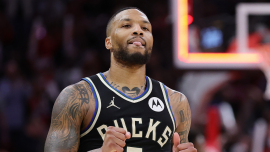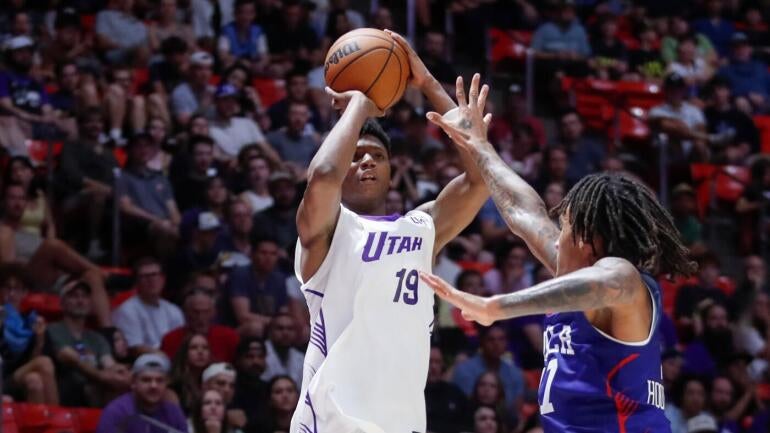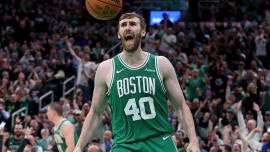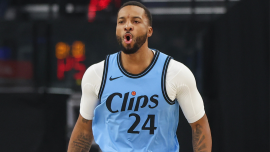Bradley Beal contract buyout explainer: Why Suns want to move on, plus landing spots for veteran scorer

The Phoenix Suns thought they’d built a championship team when they traded for Kevin Durant and Bradley Beal to pair with Devin Booker. Two years and zero playoff wins later, the Suns are dismantling that team. The process began in June, when they traded Durant to the Houston Rockets. It is seemingly continuing now, with reports indicating that they are in the process of buying out the remainder of Beal’s max contract.
There’s a key difference between those two moves, though. The Durant trade brought assets back. Opinions are mixed on Jalen Green, Dillon Brooks and Khaman Maluach, but they represent real players who will contribute to Phoenix’s rebuilding efforts next season. A buyout for Beal, at least in isolation, does not. They are preparing to cut him and deal with an enormous amount of dead money on their books just to be rid of him.
The obvious question here is… why would they do that? Why do they want to get out of the Beal business so badly that they’re willing to pay him the bulk of his money just to disappear? Well, let’s dive into this bizarre situation and try to figure out what’s happening for Beal, the Suns, and his next potential employer.
When did the buyout rumors first start?
This is important to remember: the Beal buyout talk is not a direct response to anything that has happened this offseason. The rumors started as far back as the trade deadline. “Bradley Beal, come Hell or high water, is not gonna be on this basketball team next year,” Suns insider John Gambadoro said in early April. Given Beal’s no-trade clause, there could be no such certainty that the Suns would be able to move him. The only guarantee would be some form of waiver.
It’s worth asking, at this point, whether or not that is a good idea. Beal is certainly overpaid, and his no-trade clause has obviously caused headaches for Phoenix… but he’s still a good player. Maybe even the second-best player on the post-Durant trade Suns roster. Phoenix could have used him as a sixth man behind Booker, or perhaps even started the two of them together and hoped that a higher-usage role without Durant would help get him back on track. We’re going to talk about the financial implications of a buyout in depth below, but almost any financial goal the Suns hope to achieve through a buyout could have been accomplished through other means.
All of this is to say, the Suns might not be acting entirely rationally here. This might be about behind-the-scenes problems. It might be about the headaches the no-trade clause caused in the past. It might be symbolic, a way to turn the page on this disastrous era of Suns history. But it certainly seems as though they have a one-track mind here, and that’s leading them in a potentially disastrous direction. What they are about to do, frankly, is not Phoenix’s best basketball move. We’ll explain why below. But just keep in mind, this does not seem to be a purely rational, basketball-driven decision.
So what does Phoenix gain through a buyout?
As of this writing, the Suns have a $218.6 million payroll. That bolts them past the luxury-tax line ($187.9 million) and the second apron ($207.8 million). This would be Phoenix’s second straight season above the second apron, which would not only freeze their 2033 first-round pick, but ensure that if they are above the second apron one more time in the three following seasons, their 2032 first-round pick automatically drops to No. 30 overall. Oh, and the cherry on top? The Suns are a repeat taxpayer. The new CBA instituted new luxury tax rates starting this season that are prohibitively expensive for both repeat payers and teams that go deep into the tax as the Suns have. All told, with only 13 players under contract, the Suns are currently set to pay around $385 million for their mediocre roster. That is, obviously, untenable. There is a lot of motivation for the Suns to save money right now.
The Suns could waive Beal outright, but they would still owe him the two guaranteed, supermax years left on his contract. That would obviously be untenable. Instead, they’re hoping to execute a buyout. In this arrangement, Beal would agree to give the Suns back a certain amount of money in order to secure his free agency and pick a new team. Typically, when a team and player agree to a buyout, the player gives back the amount he expects to receive from his next employer, essentially meaning their original team saves a bit of money and the new player loses none but gets to play for the team of his choice.
However, we’re relatively late in free agency. There isn’t that much money floating around free agency right now, so Beal likely wouldn’t be able to get all that much if bought out now. That means the Suns wouldn’t save all that much either. So Phoenix wants to take things a step further. In addition to a buyout, the Suns want to use the stretch provision, a rule that allows them to pay out the remaining money owed to Beal over twice as many years as currently remain on his deal, plus one more. So instead of paying Beal over two years, they’d be paying him over five. This is the same trick Milwaukee just used to dump Damian Lillard and sign Myles Turner.
Explaining the Bucks’ bold decision to use the stretch provision on Damian Lillard and sign Myles Turner
James Herbert

But there’s a hiccup here. Teams are only allowed to stretch 15% of the current salary cap at a time. Phoenix already has $3.8 million in stretched money owed to Nassir Little and E.J. Liddell on its books. Therefore, if the Suns simply waived Beal at his full contract, they legally couldn’t stretch out his deal because it would take them above that 15% threshold. To make a stretch legal, Beal would have to give up roughly $13.9 million over the life of his contract. With around $110.8 million left on his deal, that means Phoenix would agree to pay him $96.9 million over the next five years to just go away.
This would immediately lower Beal’s cap figure for next season from $53.6 million to $19.4 million. Chop $34 million off of Phoenix’s payroll for next season and suddenly the Suns are below the luxury-tax line entirely. They don’t have to deal with the second apron freezing another pick, and if they stay below the tax line for this year and next, the seasons in which they’d see these Beal savings, they can reset their repeater tax clock entirely to avoid those massive new tax rates moving forward. That’s what’s motivating the Suns here.
That seems pretty shortsighted, doesn’t it?
Well… yes. The Suns would reap all sorts of financial benefits in the short term… but they’d also be committing to three extra years of Beal payments. If they do this, Beal will be on their cap sheet for roughly $19.4 million through the 2029-30 season. Again, the Bucks are in a similar position with Lillard… but they materially improved their roster with that extra short-term flexibility by adding Turner. The Suns wouldn’t be doing that, at least not immediately. Their strategy would be more like a tax reset.
There’s obvious value in operating that way, but remember, Phoenix is very limited in the ways in which it can improve. The Suns have no more tradable first-round picks. They’d have roughly $170 million in salary on their books for the 2026-27 season. With the cap projected to rise by only 7% next season, that would put the Suns over the cap without accounting for a new deal for restricted free agent center Mark Williams, whom they just paid two first-round picks to acquire. In other words, once he’s re-signed, they will likely be limited in what they can spend in free agency.
If they’d just taken their medicine and waited out the last two years of the Beal deal, the summer of 2027 is when they’d be free of it entirely. With a stretch, they’d have to wait three more years, limiting flexibility in what will likely be critical years spent either desperately trying to put a winner around Booker or rebuilding after trading him.
Stretching Beal was the easiest way Phoenix had to achieving the short-term savings it desired, but there were other options on the table even if they’d accomplished less. The Durant trade, for example, was ultimately a net increase in payroll for Phoenix. They could have simply declined their $8.1 million team option on Vasilije Micić. Instead, they picked it up to use him as matching salary in the Williams trade. They could move role players like Grayson Allen or Royce O’Neale in trades that shed salary. Even if they didn’t stretch Beal, just buying him out with that $13.9 million saved money over two years would have represented real savings. They might not have had another way to duck the tax, but getting below the second apron at least was a feasible goal.
Instead, the Suns were hellbent on breaking up with Beal. They’re going to pay a long-term price for that, but they’re frankly paying a long-term price for just about everything Mat Ishbia has done as their owner. He traded for Durant mere days after acquiring the team. He doesn’t really operate with the long term in mind. That has punished him so far. It likely will with Beal as well. But speaking of Beal, where does that leave him?
Where is Beal going to end up?
As is the case with Lillard, Beal doesn’t really have to think about money here. He’s going to be paid so much by the Suns moving forward that he can afford to sign for low money to land in the perfect basketball situation. Don’t be surprised if Beal has that team lined up as soon as the buyout is official. For now, five teams have drawn the bulk of the attention.
- The Heat have been linked to Beal in past transaction cycles. They have the full mid-level exception ($14.1 million) still at their disposal, though they only have around $11.1 million in first-apron hard cap space, and more likely, they’d want to stay below the luxury tax, which would cap their offer at around the $5.5 million in room beneath it they currently have.
- The Bucks already took a major swing by bringing in Turner. Beal could replace Lillard as their high-scoring guard. The Bucks have already used most of their cap room mid-level exception, so practically speaking, he’d be signing for the veteran’s minimum ($3.9 million for a player with at least 10 years of experience like Beal) unless they make other moves that open up money.
- The Nuggets have revamped their bench this offseason, but still have their full mid-level exception to spend. However, they’re only $5.9 million below their first-apron hard cap, so that’s as much as they could offer. He’d be a tad redundant with Tim Hardaway Jr. in place, but think of how disastrous Denver’s bench has been in recent years. If the Nuggets can get a player this talented at this price, they should do it and figure out the fit later.
- The Clippers badly need a secondary creator. Their offense struggled mightily whenever James Harden sat last year. They have around $5.3 million left on their mid-level exception after signing Brook Lopez. Keep in mind, the Clippers have owned the buyout market in recent years. Nic Batum, Reggie Jackson and Ben Simmons have all come to the Clippers following buyouts. For whatever reason, this is an area in which they’ve tended to thrive.
- The last thing the Lakers need is more offense, but they’ve never been the sort of team to turn down star power, and great players are often drawn to them. They theoretically have the $5.1 million bi-annual exception available to them, but their bizarre decision to pay Jaxson Hayes more than the minimum deprived them of the hard-cap flexibility they’d need to actually use it. So, like the Bucks, they’re functionally operating with the minimum unless further moves change that.
These are the teams that pop up most, but any team with a roster spot and the flexibility to offer the minimum is feasibly on the table. In Phoenix, Beal was a $20 million player making $50 million. Obviously, that’s an overpay… but a $20 million player is still valuable, especially if he can be had for the minimum or something close. So realistically, a lot of teams are going to call, and it’s going to come down to what Beal wants out of his next team.
If it’s a matter of role size? The Bucks make a lot of sense. They badly need a high-scoring guard with Lillard (and Khris Middleton for that matter) now gone. If it’s a matter of location? Los Angeles almost always wins, and when it doesn’t, it’s usually because New York does. Beal spent most of his career in Washington, so perhaps a team in the northeast would appeal to him from a family perspective. After all, his family was reportedly happily settled in Phoenix, so that is likely a meaningful factor here. If it’s about winning? Denver likely stands out merely by having the best player in the NBA.
But almost anyone is feasible. It’s just up to Beal to figure out what he wants. Of course, that was the case two years ago thanks to his no-trade clause. He wound up in Phoenix and that went badly. Hopefully the lessons he learned in that time lead him somewhere better this time around.








